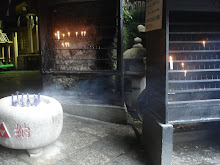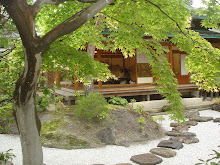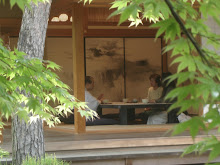I went back to the bookstore. I was at the counter where I had collected my Hanko. It is also the place where they sell stamps and photocopy cards and other stationary needs. My phrasebook was in my pocket. I had learned the phrase: 'Ki-te o ku-da-sai': 'Stamps please'. My plan was to hold up 4 fingers to signal that I wanted 4 stamps. I hadn't been able to figure out how to express the number 4. Japanese, like Irish, has a distinct counting system for people (duine, beirt, triur...) but Japanese is even more specific. Besides the number required or described there is another classifying word that must be added to the number. The classifying word is used to give an added precision and signals whether the object being counted is small, or long, or has a binding, or is an animal, or is a vehicle, or whether you can drink it or it eat it, or whether the number relates to an age, or the floor of a building, or the time - the list of classifications continue - .
More difficult still the classifcation word changes depending on the number - so the classification for long objects changes from hon to pon to bon (the classification for animals changes from hiki to piki to biki) according to the number required or described. It was too much of a challenge to figure out what 4 stamps might be - perhaps it might be 'yon-ko kite' but you can also use 'shi' instead of 'yon' to signal '4'. A colleague here had told me that a surprise best-selling book in Japan last year was a dictionary with lists of how to correctly count things - so obviously the Japanese themselves need assistance with doubt and potential confusion. I was just going to wave four fingers and say : 'Ki-te o ku-da-sai'.
I came to the hatch - there were three women working at their desks among stacks of stationary. 'Sumi-ma-sen' (excuse me) 'Ki-te o ku-da-sai'. The women looked up. 'Ki-te o ku-da-sai' -waving my fingers. They looked at each other. One of them stood up and approached. 'Hai' she said - which doesn't so much mean 'yes' as 'I understand' - because Japanese people never want to say no or even distrub the connection with a question - they will just say 'Hai'. 'Ki-te o ku-da-sai' -waving my fingers. We continued at this for a few more attempts - she had moved so close to me that she was staring up into my nostrils and remarkably, I could sense some irritation: I didn't think that Japanese people could get irritated. She was still saying 'Hai' I knew she was unhappy and I was backing away. I waved the envelopes. 'Kit TE!' she said. 'Hai' said I. 'How many?' she asked. 'Four'.
I ran through the scenario with my colleagues: what went wrong? They said - you were saying 'ki-te' - it means -'come here'. I practised Kit TE! a number of times. 'Good', they said. 'Phew', I said: 'Got it - Ke TE!' There was a silence - Hmm - no, you've just asked her to cut you something. 'And there would be nothing there for her to cut', one of my colleagues helpfully pointed out. 'ki-te' Kit TE! Ke TE! I was exasperated. They nodded in a friendly way. Then one suggested: 'Maybe you could ask for: "postage stamps please".' "Yes", they agreed. "Ask for postage stamps."
Monday, May 12
Subscribe to:
Post Comments (Atom)







No comments:
Post a Comment